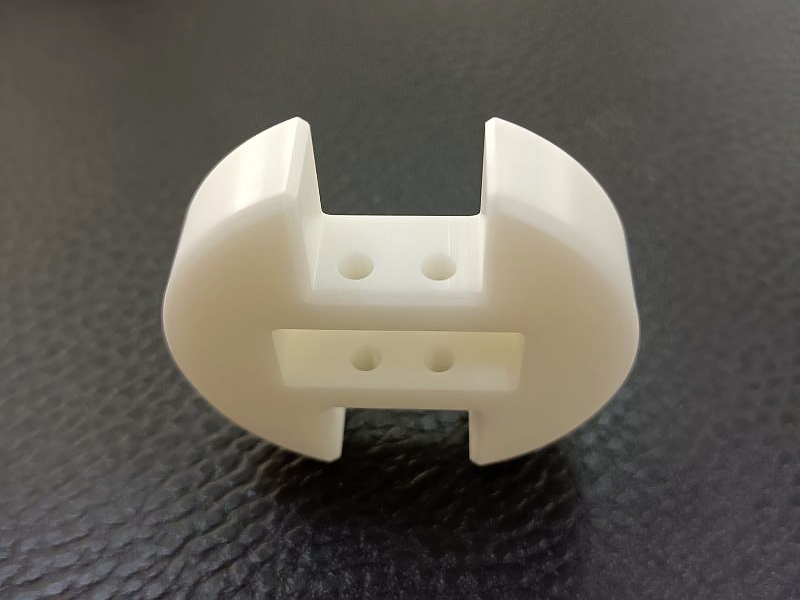High-Temperature Products CNC Machining Service of Boron Nitride (BN)
Introduction
Boron Nitride (BN) is an advanced ceramic material prized for its exceptional thermal stability, electrical insulation, and resistance to thermal shock, making it highly suitable for CNC machining of high-temperature products. Widely used in sectors like aerospace, power generation, and electronics manufacturing, BN machined components can reliably operate at temperatures exceeding 1800°C.
Through precise ceramic CNC machining, manufacturers achieve complex geometries with tight tolerances (±0.005 mm), producing durable, heat-resistant components such as insulators, crucibles, and furnace fixtures for demanding industrial applications.
Boron Nitride (BN) Material Properties
Material Performance Comparison Table
Material | Max. Operating Temp (°C) | Thermal Conductivity (W/m·K) | Dielectric Strength (kV/mm) | Density (g/cm³) | Thermal Expansion (10⁻⁶/K) | Typical Applications | Advantages |
|---|---|---|---|---|---|---|---|
1800-2100 | 30-60 | 35-40 | 2.1-2.3 | 1-4 | Furnace components, electrical insulators | Superior thermal shock resistance, high dielectric strength | |
1500-1700 | 25-35 | 20-30 | 3.9 | 6-8 | Electrical insulators, pump seals | Good thermal and electrical insulation, high hardness | |
1000-1200 | 2-3 | 10-15 | 6.05 | 10 | Structural ceramics, implants | High fracture toughness, mechanical strength | |
1200-1400 | 15-25 | 18-22 | 3.2 | 3-4 | Bearings, engine components | High strength, good thermal stability |
Material Selection Strategy
Selecting Boron Nitride (BN) for CNC machining involves considering extreme temperature conditions, thermal shock resistance, and electrical insulation:
BN is optimal for applications requiring stability at extremely high temperatures (up to 2100°C), exceptional thermal shock resistance, and excellent dielectric strength (35-40 kV/mm), suitable for electronics and high-temperature furnaces.
Alumina is best for moderate-high temperature insulation, with higher hardness but lower thermal shock resistance.
Zirconia suits mechanically demanding environments but with lower thermal conductivity and maximum temperature limits.
Silicon Nitride offers excellent strength and stability but at relatively lower maximum operating temperatures compared to BN.
CNC Machining Processes for Boron Nitride Components
CNC Machining Process Comparison
CNC Process | Accuracy (mm) | Surface Finish (Ra µm) | Typical Applications | Advantages |
|---|---|---|---|---|
±0.01 | 0.4-0.8 | Complex insulators, furnace components | Precision shaping of complex geometries | |
±0.003 | 0.05-0.2 | Precision sealing surfaces, high accuracy parts | Ultra-high precision and surface finish | |
±0.01 | 0.6-1.2 | Component holes, internal channels | Precise hole placement in hard ceramics | |
±0.005 | 0.1-0.4 | High-tolerance components, fixtures | Excellent dimensional accuracy and repeatability |
CNC Process Selection Strategy
Choosing the appropriate CNC machining processes for BN components depends on precision, surface quality, and complexity requirements:
CNC Milling is ideal for producing complex BN shapes, such as custom electrical insulators and furnace elements.
CNC Grinding achieves ultra-high surface finishes (Ra ≤0.2 µm), critical for sealing surfaces and high-precision thermal components.
CNC Drilling accurately creates holes and channels in BN components, necessary for precise assembly or airflow control.
Precision Machining ensures dimensional stability (±0.005 mm), suitable for tight-tolerance furnace fixtures and electronic components.
Surface Treatments for CNC Machined BN Components
Surface Treatment Comparison
Treatment Method | Hardness (HV) | Corrosion Resistance | Max. Operating Temp (°C) | Applications | Key Features |
|---|---|---|---|---|---|
2200-2500 | Excellent | 1300°C | Aerospace, furnaces | Superior insulation, high-temperature protection | |
Base Material | Excellent | 600°C | High-purity applications | Enhanced surface cleanliness, reduced friction | |
600-700 | Excellent | 260°C | Non-stick, chemically resistant surfaces | Superior chemical resistance and low friction | |
Base Material | Excellent | 400°C | Electrical insulators, clean environments | Enhanced corrosion resistance, surface purity |
Surface Treatment Selection Strategy
Surface treatments for BN components are selected based on operational conditions and functional needs:
Thermal Barrier Coatings (TBC) protect BN components operating continuously at temperatures up to 1300°C.
Electropolishing enhances surface smoothness and cleanliness, critical for high-purity and low-friction applications.
Teflon Coating provides low-friction, chemically resistant surfaces for BN parts in chemical handling or processing environments.
Passivation ensures enhanced corrosion resistance and purity, critical for electronic insulators and high-performance assemblies.
Typical Prototyping Methods
Ceramic 3D Printing: Produces intricate prototypes with accuracy (±0.1 mm) and rapid validation of designs for BN components.
CNC Machining Prototyping: High-precision prototyping (±0.005 mm), verifying dimensional stability and functionality prior to mass production.
Powder Bed Fusion: Achieves high accuracy (±0.05 mm), suitable for validating complex BN geometries before CNC machining.
Quality Assurance Procedures
CMM Inspection (ISO 10360-2): Ensures precise dimensional accuracy within ±0.005 mm.
Surface Finish Testing (ISO 4287): Validates that surface roughness meets specifications (Ra ≤0.2 µm).
Thermal Shock Testing (ASTM C1525): Confirms thermal shock resistance at operating temperatures up to 1800°C.
Dielectric Strength Testing (ASTM D149): Verifies electrical insulation performance (≥35 kV/mm).
Material Purity and Composition Analysis (XRD, SEM): Ensures consistent material quality and chemical purity.
ISO 9001:2015 Quality Management: Maintains traceability, repeatability, and comprehensive documentation throughout the machining process.
Key Industry Applications
Furnace insulators and fixtures
Semiconductor processing equipment
High-temperature electrical components
Aerospace heat shields
Related FAQs:
What makes Boron Nitride ideal for high-temperature CNC machining?
Which CNC machining methods are best suited for Boron Nitride parts?
How do surface treatments enhance Boron Nitride component performance?
Which industries commonly utilize CNC machined BN components?
What quality controls ensure precision in BN CNC machining?

